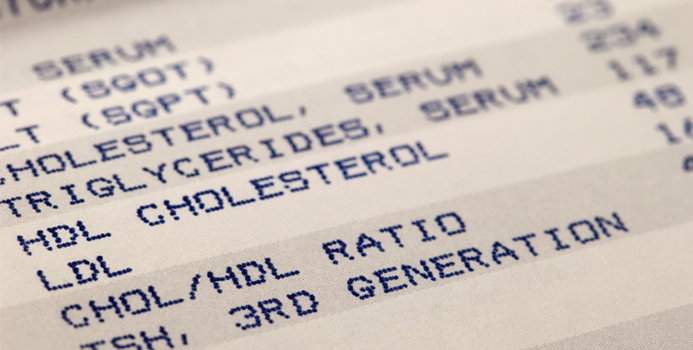Often there exists some confusion about cholesterol, especially since you find some in your body and others in food. There are two types of cholesterol, dietary cholesterol which comes from food, and serum or blood cholesterol which is found in the bloodstream. It is a fatlike substance, but has a different structure from fat and performs different functions in the body. Cholesterol cannot be broken down so the body does not derive any energy from it. Cholesterol does not mix with water, so to be carried in the bloodstream it needs to be combined with fats and proteins, also known as lipoproteins. Lipoproteins carry cholesterol to and from your cells.
Despite its commonly associated bad image, cholesterol performs many essential duties in the body and is a part of every cell in your body. It is a part of some hormones, including sex hormones like estrogen. It is also needed to make bile, which assists the body in absorbing and digesting fat. It even plays a role in bone building by combining with sunlight in your skin to change to vitamin D.
The cholesterol found in your body is produced primarily by your liver, although all cells in your body are capable of making it. If your body makes too much cholesterol, the risk for heart disease and related complications increases. Your body produces enough cholesterol that you do not need to consume additional amounts.
Dietary cholesterol is primarily found in foods and beverages of animal origin. Dairy, meat, fish, eggs and poultry all contain cholesterol. Plants do not produce cholesterol, only animals. Dietary cholesterol is a contributing factor to elevated blood cholesterol levels if too much is consumed. Not all dietary cholesterol becomes blood cholesterol. Furthermore, trans fats and saturated fats are show to have a more significant effect on blood cholesterol levels than dietary cholesterol does alone.
When the terms "good" and "bad" cholesterol are discussed, you are really talking about the two types of lipoproteins carrying cholesterol in your blood, not cholesterol found in food. These terms are associated with risk factors for heart disease. High-Density Lipoproteins (HDL), are considered "good" and linked to lower risk of heart disease. HDL works by removing the "bad" cholesterol from your blood. Low-Density Lipoproteins (LDL) is considered "bad" cholesterol and is associated with a higher risk of heart disease and increased plaque formation in your blood vessels and arteries. Total Blood/Serum Cholesterol is a combination of both HDL and LDL cholesterol. Your food choices do affect LDL levels -- the lower the saturated fat, trans fat and cholesterol in your diet, the lower your LDL blood cholesterol levels will typically be. Triglycerides are a type of fat found in the body that is a result of excess calories consumed. A high triglyceride level combined with low HDL cholesterol or high LDL cholesterol is associated with atherosclerosis, the buildup of fatty deposits in artery walls that increases the risk for heart attack and/or stroke.
The best ways to lower your serum cholesterol, lower LDL cholesterol and raise your HDL cholesterol is through being physically active and consuming a balanced healthy diet. For optimal heart health, make sure your diet includes lots of fiber, omega-3's, polyunsaturated fats, potassium and fruits and vegetables.
To check your Serum Cholesterol levels, ask your doctor to complete a fasting lipoprotein profile. Your Total Serum Cholesterol is calculated by HDL+LDL+20% of your triglyceride level. A score of less than 180mg/dl is considered optimal.
The National Cholesterol Education Program (NCEP) has set the following guidelines for lipids (total cholesterol, triglycerides, high density lipoprotein [HDL], and low density lipoprotein [LDL] cholesterol) in adults ages 18 and up:
TOTAL CHOLESTEROL
Desirable:
Borderline high: 200-239 mg/dL
High: > or =240 mg/dL
The National Cholesterol Education Program (NCEP) and National Health and Nutrition Examination Survey (NHANES) has set the following guidelines for lipids (total cholesterol, triglycerides, HDL, and LDL cholesterol) in children ages 2-17:
TOTAL CHOLESTEROL
Desirable:
Borderline high: 170-199 mg/dL
High: > or =200 mg/dL

Emily DeLacey MS, RD is a Registered Dietitian and currently working in Jamaica as a HIV/ AIDS Prevention Specialist. She attended Central Washington University for her Bachelor's Degree in Science and Dietetics and continued on after her internship to Kent State University for her Master's Degree in Science and Nutrition, with a focus on public health and advocacy. She served as a U.S. Peace Corps Volunteer in Malawi 2012-2014 working as a Community Health Advisor in a rural village, immersing in the joys of life without electricity or running water. She has been to 20+ countries and 47 of the 50 states in the US. Traveling, adventuring and experiencing new cultures has made her a passionate advocate for the equality of nutrition and wellness for all people.



